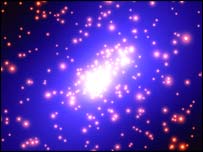NASA and the European Space Agency scientists have finished mapping a galaxy cluster where the concentration of dark matter reaches about 85%. The researchers hope that the "mass map" will help to understand the composition and nature of dark matter
Tal Eitan, YNET

The cluster CL0024+1654. The bright colors are actually the dark matter scattered in the cluster as seen in X-ray photography Photo: NASA
A team of astronomers from the United States and Europe has finished mapping a cluster of galaxies - one of the most complex and massive astronomical structures in the visible universe. The scientists estimate that the new map drawn will help explain the processes occurring in complex star clusters, as well as shed light on the dark matter, which intrigues many researchers.
The map was completed using observations and photographs from the Hubble Space Telescope, and was assembled by a team of researchers from the American Space Agency (NASA) and European Space Agency personnel.
Galaxy clusters are a very large and stable astronomical system, consisting of billions of stars concentrated together densely, in a relatively small area. These clusters help researchers to test the physical connections and the mutual effects between the dark matter and the visible matter in the universe.
Already in 1937, astronomers discovered that the visible matter, known to science, constitutes only a small part of the total mass of galaxy clusters. Physical studies conducted following X-ray and other observations showed that over 80% of the mass of the clusters consists of invisible matter. That mysterious substance, whose composition or structure is not yet known to science, was called "dark matter".
Despite the early discovery of the existence of that dark matter, only in recent years have researchers been able to find methods to photograph and trace the interaction processes of the matter with its environment and its physical behavior. The astronomers estimated that as they probe deeper and learn about the effects of the dark matter on its environment, they will be able to decipher its composition and understand what its chemical and physical nature is.
Extra long observations
To unravel the mysteries of dark matter, the group of researchers used the Hubble Space Telescope to construct a "mass map" that accurately defines the distribution of mass in the CL0024+1654 galaxy cluster. For the purpose of preparing the map, the researchers were helped by 120 hours of photography by the Hubble telescope. This is the longest observation duration spent to date to photograph a galaxy cluster. Despite the cluster's distance from Earth (over 4.5 billion light years), its enormous size allowed researchers to study it in depth and finally - to map it almost perfectly and accurately.
Now, with the completion of the map, for the first time the researchers can observe the distribution of the dark matter in the cluster, and study its effect on the visible matter. The researchers hope that deciphering the map and the conclusions that will be learned from its analysis will help science understand the nature of dark matter and its role in galaxy clusters - and its role in the formation of the universe and celestial bodies.
